Corporate Finance: Analyzing Investment Decisions with WACC and NPV
VerifiedAdded on 2020/05/28
|9
|1402
|28
Homework Assignment
AI Summary
This corporate finance assignment delves into several key areas of financial analysis, including the calculation of Weighted Average Cost of Capital (WACC) and Net Present Value (NPV) for a hypothetical project. The assignment begins by calculating the WACC for a company, considering both the cost of equity and the cost of bonds. Subsequently, it proceeds to analyze a proposed project, determining its NPV under normal conditions, as well as under best-case and worst-case scenarios. The analysis involves detailed cash flow projections, including the consideration of depreciation, taxes, and terminal value. The student then provides recommendations based on the NPV results and discusses the factors that influence investment decisions, emphasizing the importance of financial analysis in determining project feasibility. The assignment concludes with a discussion on the importance of considering various scenarios and the role of a financial analyst in presenting the findings to management.
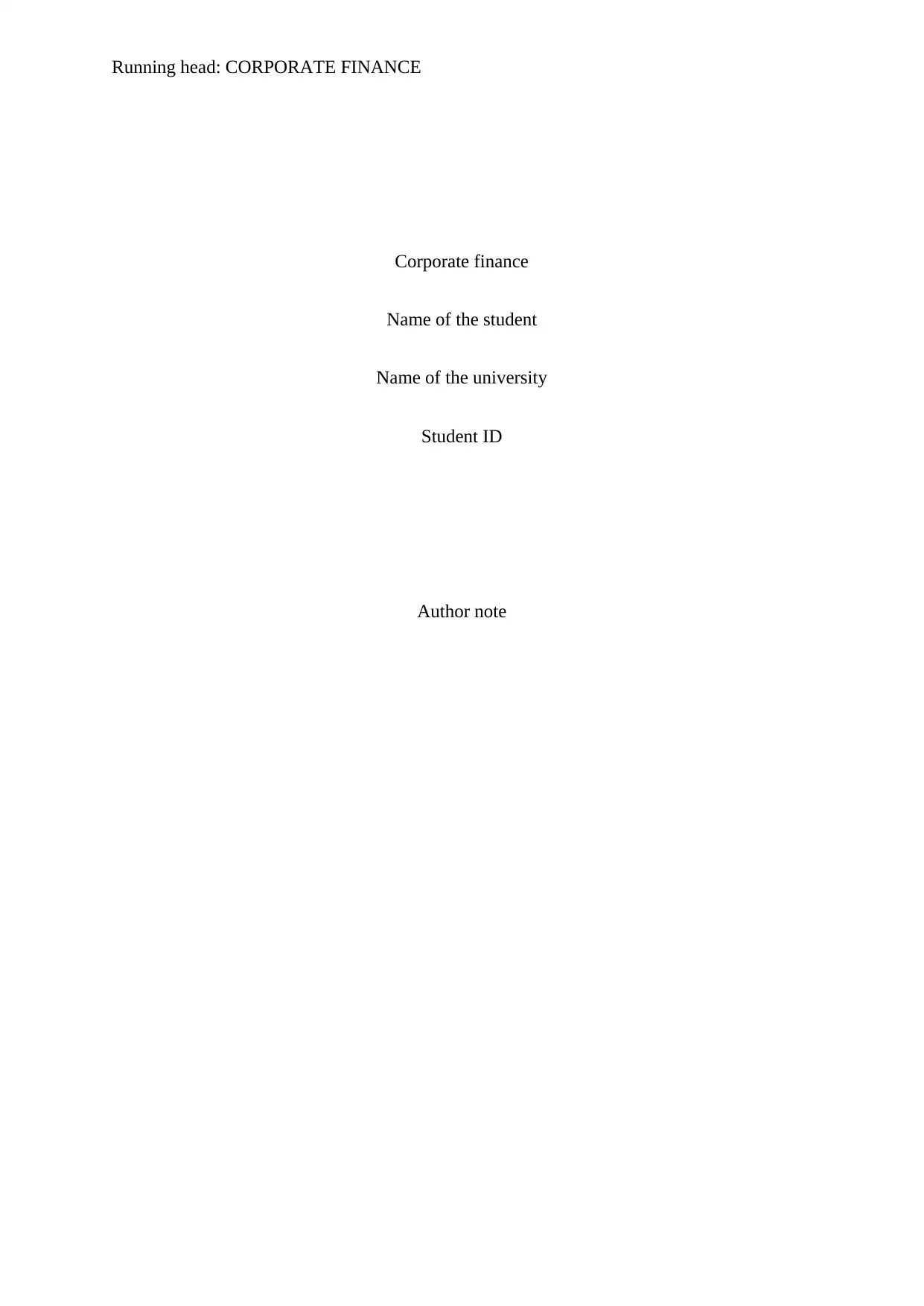
Running head: CORPORATE FINANCE
Corporate finance
Name of the student
Name of the university
Student ID
Author note
Corporate finance
Name of the student
Name of the university
Student ID
Author note
Paraphrase This Document
Need a fresh take? Get an instant paraphrase of this document with our AI Paraphraser

1CORPORATE FINANCE
Table of Contents
Answer a.....................................................................................................................................2
Answer b....................................................................................................................................3
Answer c.....................................................................................................................................5
Answer d....................................................................................................................................7
Reference....................................................................................................................................8
Table of Contents
Answer a.....................................................................................................................................2
Answer b....................................................................................................................................3
Answer c.....................................................................................................................................5
Answer d....................................................................................................................................7
Reference....................................................................................................................................8
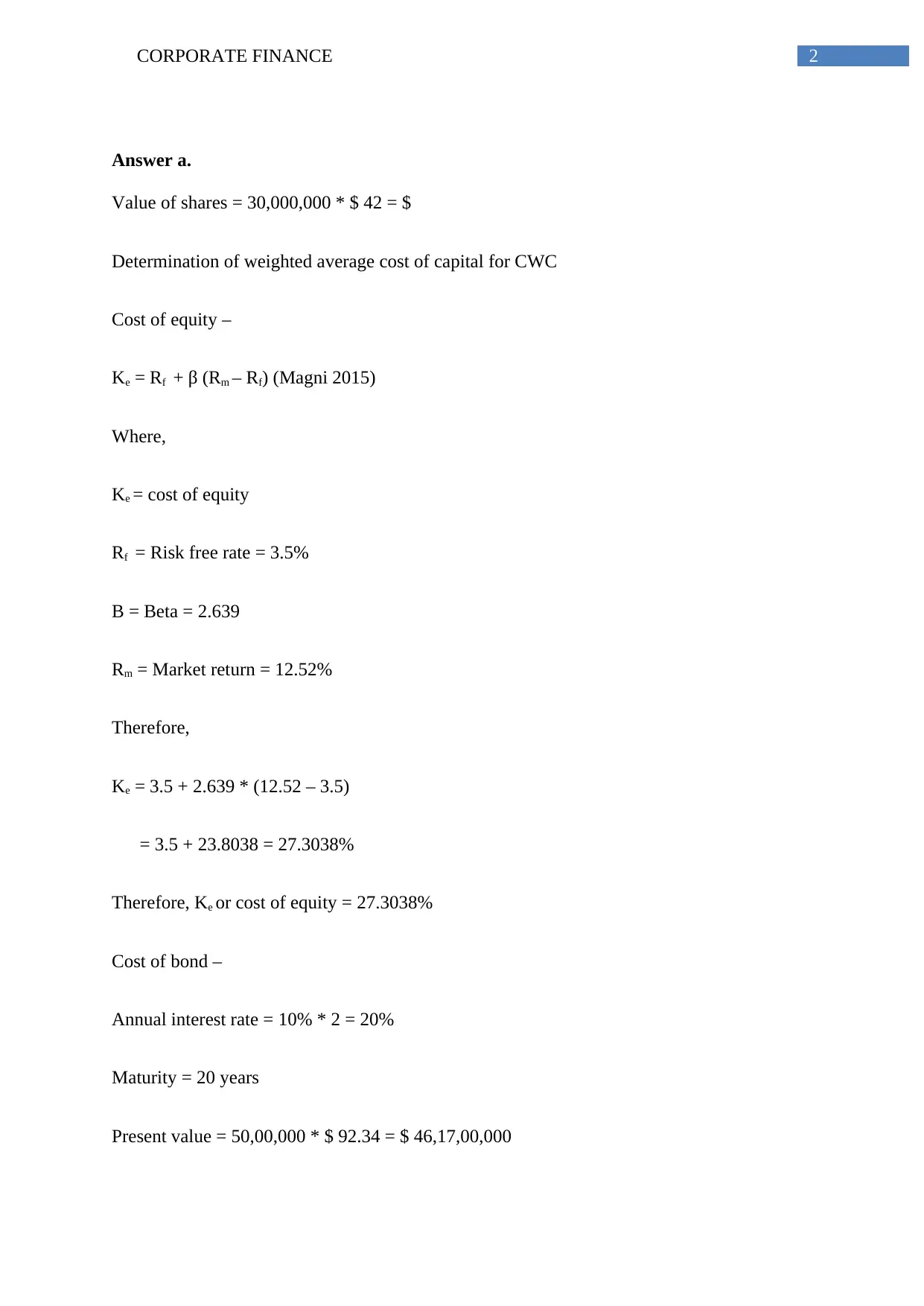
2CORPORATE FINANCE
Answer a.
Value of shares = 30,000,000 * $ 42 = $
Determination of weighted average cost of capital for CWC
Cost of equity –
Ke = Rf + β (Rm – Rf) (Magni 2015)
Where,
Ke = cost of equity
Rf = Risk free rate = 3.5%
Β = Beta = 2.639
Rm = Market return = 12.52%
Therefore,
Ke = 3.5 + 2.639 * (12.52 – 3.5)
= 3.5 + 23.8038 = 27.3038%
Therefore, Ke or cost of equity = 27.3038%
Cost of bond –
Annual interest rate = 10% * 2 = 20%
Maturity = 20 years
Present value = 50,00,000 * $ 92.34 = $ 46,17,00,000
Answer a.
Value of shares = 30,000,000 * $ 42 = $
Determination of weighted average cost of capital for CWC
Cost of equity –
Ke = Rf + β (Rm – Rf) (Magni 2015)
Where,
Ke = cost of equity
Rf = Risk free rate = 3.5%
Β = Beta = 2.639
Rm = Market return = 12.52%
Therefore,
Ke = 3.5 + 2.639 * (12.52 – 3.5)
= 3.5 + 23.8038 = 27.3038%
Therefore, Ke or cost of equity = 27.3038%
Cost of bond –
Annual interest rate = 10% * 2 = 20%
Maturity = 20 years
Present value = 50,00,000 * $ 92.34 = $ 46,17,00,000
⊘ This is a preview!⊘
Do you want full access?
Subscribe today to unlock all pages.

Trusted by 1+ million students worldwide
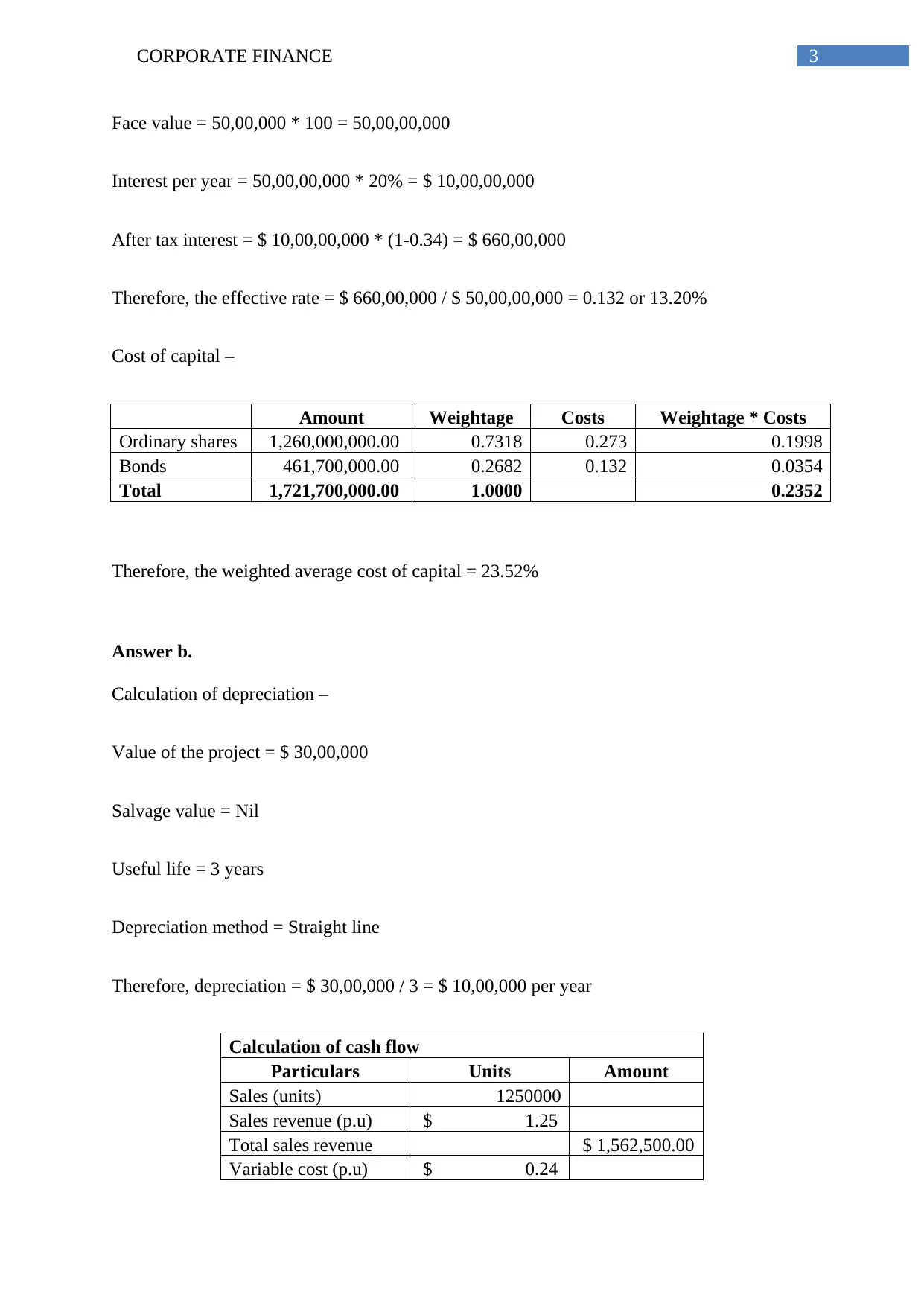
3CORPORATE FINANCE
Face value = 50,00,000 * 100 = 50,00,00,000
Interest per year = 50,00,00,000 * 20% = $ 10,00,00,000
After tax interest = $ 10,00,00,000 * (1-0.34) = $ 660,00,000
Therefore, the effective rate = $ 660,00,000 / $ 50,00,00,000 = 0.132 or 13.20%
Cost of capital –
Amount Weightage Costs Weightage * Costs
Ordinary shares 1,260,000,000.00 0.7318 0.273 0.1998
Bonds 461,700,000.00 0.2682 0.132 0.0354
Total 1,721,700,000.00 1.0000 0.2352
Therefore, the weighted average cost of capital = 23.52%
Answer b.
Calculation of depreciation –
Value of the project = $ 30,00,000
Salvage value = Nil
Useful life = 3 years
Depreciation method = Straight line
Therefore, depreciation = $ 30,00,000 / 3 = $ 10,00,000 per year
Calculation of cash flow
Particulars Units Amount
Sales (units) 1250000
Sales revenue (p.u) $ 1.25
Total sales revenue $ 1,562,500.00
Variable cost (p.u) $ 0.24
Face value = 50,00,000 * 100 = 50,00,00,000
Interest per year = 50,00,00,000 * 20% = $ 10,00,00,000
After tax interest = $ 10,00,00,000 * (1-0.34) = $ 660,00,000
Therefore, the effective rate = $ 660,00,000 / $ 50,00,00,000 = 0.132 or 13.20%
Cost of capital –
Amount Weightage Costs Weightage * Costs
Ordinary shares 1,260,000,000.00 0.7318 0.273 0.1998
Bonds 461,700,000.00 0.2682 0.132 0.0354
Total 1,721,700,000.00 1.0000 0.2352
Therefore, the weighted average cost of capital = 23.52%
Answer b.
Calculation of depreciation –
Value of the project = $ 30,00,000
Salvage value = Nil
Useful life = 3 years
Depreciation method = Straight line
Therefore, depreciation = $ 30,00,000 / 3 = $ 10,00,000 per year
Calculation of cash flow
Particulars Units Amount
Sales (units) 1250000
Sales revenue (p.u) $ 1.25
Total sales revenue $ 1,562,500.00
Variable cost (p.u) $ 0.24
Paraphrase This Document
Need a fresh take? Get an instant paraphrase of this document with our AI Paraphraser
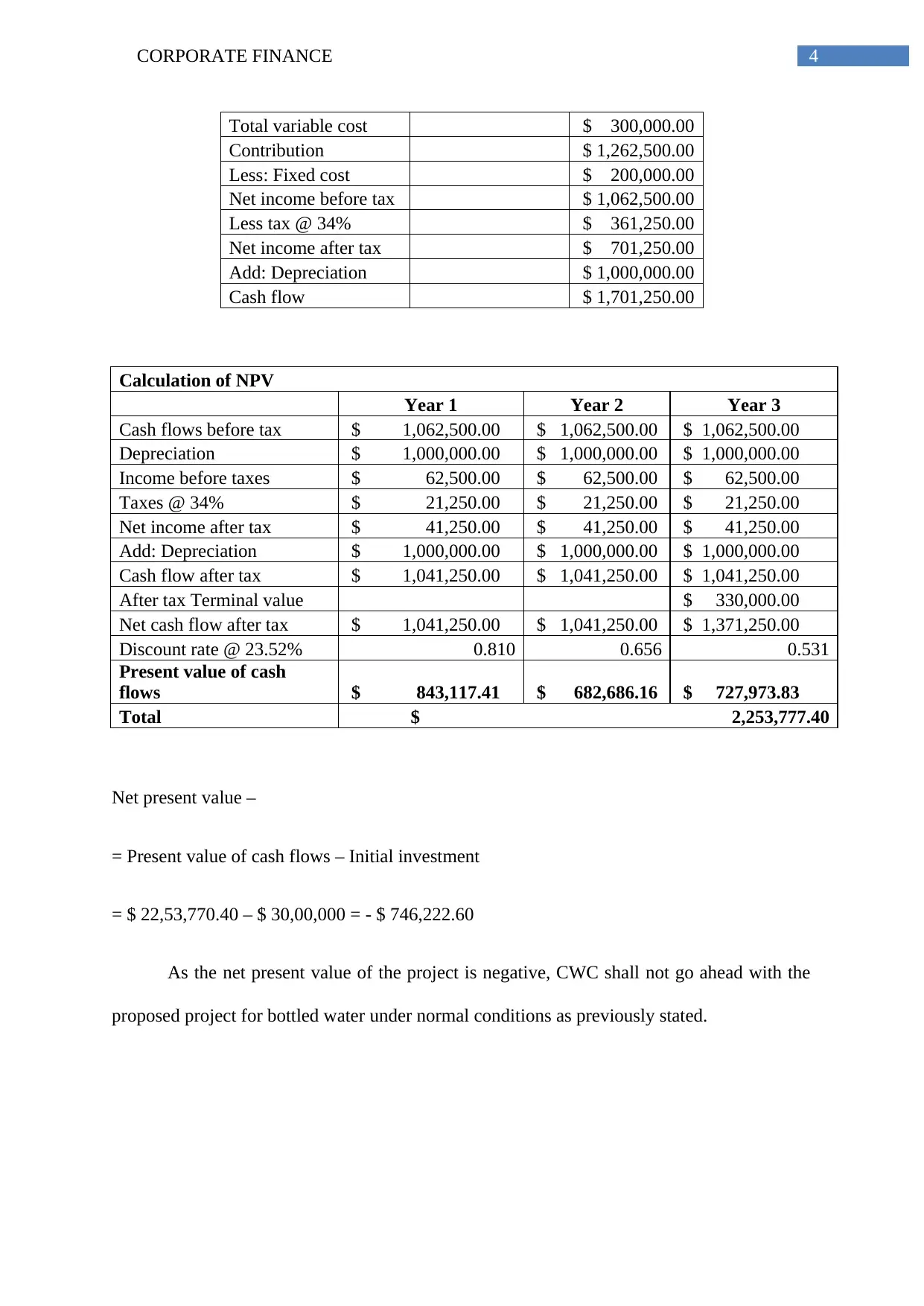
4CORPORATE FINANCE
Total variable cost $ 300,000.00
Contribution $ 1,262,500.00
Less: Fixed cost $ 200,000.00
Net income before tax $ 1,062,500.00
Less tax @ 34% $ 361,250.00
Net income after tax $ 701,250.00
Add: Depreciation $ 1,000,000.00
Cash flow $ 1,701,250.00
Calculation of NPV
Year 1 Year 2 Year 3
Cash flows before tax $ 1,062,500.00 $ 1,062,500.00 $ 1,062,500.00
Depreciation $ 1,000,000.00 $ 1,000,000.00 $ 1,000,000.00
Income before taxes $ 62,500.00 $ 62,500.00 $ 62,500.00
Taxes @ 34% $ 21,250.00 $ 21,250.00 $ 21,250.00
Net income after tax $ 41,250.00 $ 41,250.00 $ 41,250.00
Add: Depreciation $ 1,000,000.00 $ 1,000,000.00 $ 1,000,000.00
Cash flow after tax $ 1,041,250.00 $ 1,041,250.00 $ 1,041,250.00
After tax Terminal value $ 330,000.00
Net cash flow after tax $ 1,041,250.00 $ 1,041,250.00 $ 1,371,250.00
Discount rate @ 23.52% 0.810 0.656 0.531
Present value of cash
flows $ 843,117.41 $ 682,686.16 $ 727,973.83
Total $ 2,253,777.40
Net present value –
= Present value of cash flows – Initial investment
= $ 22,53,770.40 – $ 30,00,000 = - $ 746,222.60
As the net present value of the project is negative, CWC shall not go ahead with the
proposed project for bottled water under normal conditions as previously stated.
Total variable cost $ 300,000.00
Contribution $ 1,262,500.00
Less: Fixed cost $ 200,000.00
Net income before tax $ 1,062,500.00
Less tax @ 34% $ 361,250.00
Net income after tax $ 701,250.00
Add: Depreciation $ 1,000,000.00
Cash flow $ 1,701,250.00
Calculation of NPV
Year 1 Year 2 Year 3
Cash flows before tax $ 1,062,500.00 $ 1,062,500.00 $ 1,062,500.00
Depreciation $ 1,000,000.00 $ 1,000,000.00 $ 1,000,000.00
Income before taxes $ 62,500.00 $ 62,500.00 $ 62,500.00
Taxes @ 34% $ 21,250.00 $ 21,250.00 $ 21,250.00
Net income after tax $ 41,250.00 $ 41,250.00 $ 41,250.00
Add: Depreciation $ 1,000,000.00 $ 1,000,000.00 $ 1,000,000.00
Cash flow after tax $ 1,041,250.00 $ 1,041,250.00 $ 1,041,250.00
After tax Terminal value $ 330,000.00
Net cash flow after tax $ 1,041,250.00 $ 1,041,250.00 $ 1,371,250.00
Discount rate @ 23.52% 0.810 0.656 0.531
Present value of cash
flows $ 843,117.41 $ 682,686.16 $ 727,973.83
Total $ 2,253,777.40
Net present value –
= Present value of cash flows – Initial investment
= $ 22,53,770.40 – $ 30,00,000 = - $ 746,222.60
As the net present value of the project is negative, CWC shall not go ahead with the
proposed project for bottled water under normal conditions as previously stated.
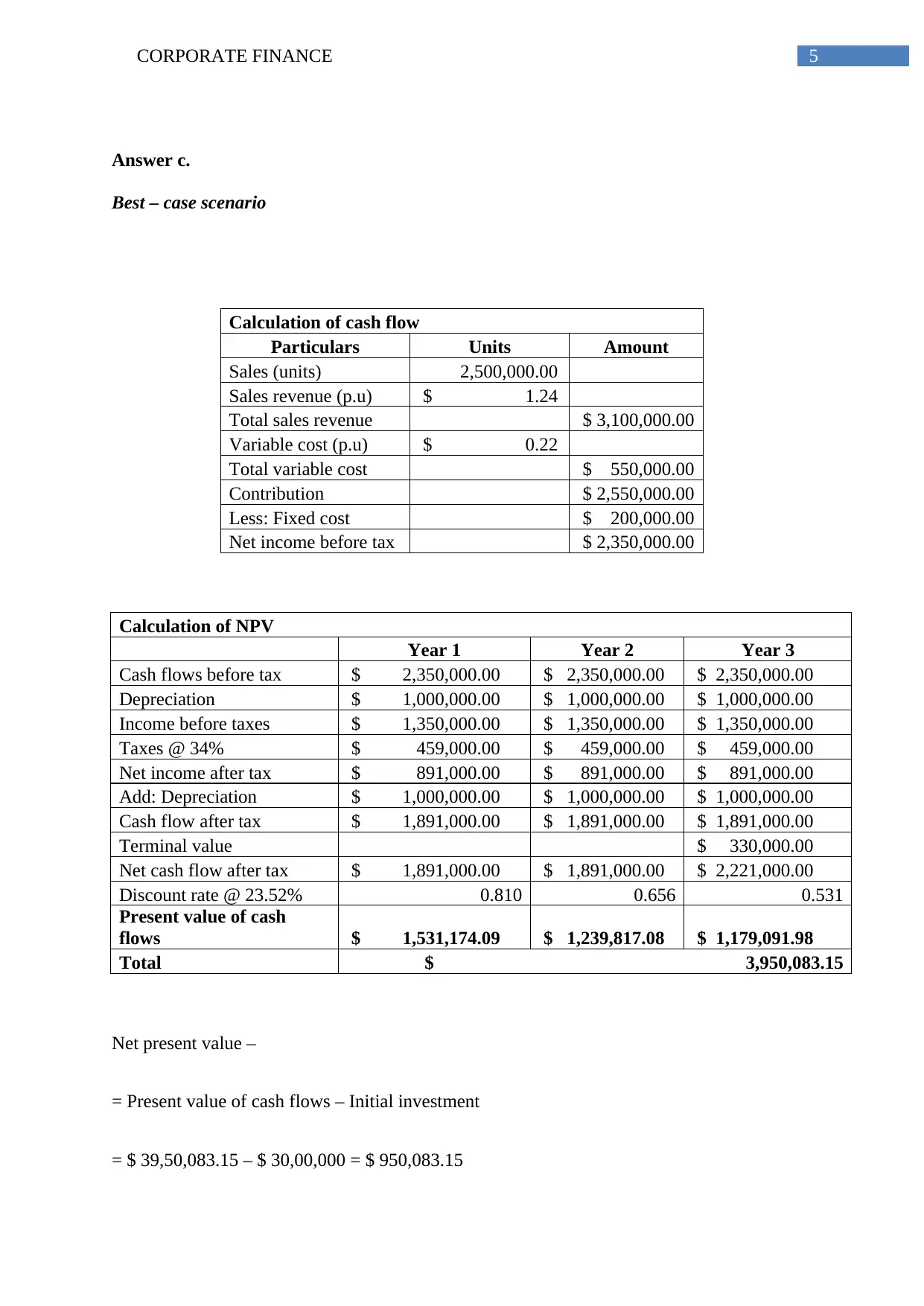
5CORPORATE FINANCE
Answer c.
Best – case scenario
Calculation of cash flow
Particulars Units Amount
Sales (units) 2,500,000.00
Sales revenue (p.u) $ 1.24
Total sales revenue $ 3,100,000.00
Variable cost (p.u) $ 0.22
Total variable cost $ 550,000.00
Contribution $ 2,550,000.00
Less: Fixed cost $ 200,000.00
Net income before tax $ 2,350,000.00
Calculation of NPV
Year 1 Year 2 Year 3
Cash flows before tax $ 2,350,000.00 $ 2,350,000.00 $ 2,350,000.00
Depreciation $ 1,000,000.00 $ 1,000,000.00 $ 1,000,000.00
Income before taxes $ 1,350,000.00 $ 1,350,000.00 $ 1,350,000.00
Taxes @ 34% $ 459,000.00 $ 459,000.00 $ 459,000.00
Net income after tax $ 891,000.00 $ 891,000.00 $ 891,000.00
Add: Depreciation $ 1,000,000.00 $ 1,000,000.00 $ 1,000,000.00
Cash flow after tax $ 1,891,000.00 $ 1,891,000.00 $ 1,891,000.00
Terminal value $ 330,000.00
Net cash flow after tax $ 1,891,000.00 $ 1,891,000.00 $ 2,221,000.00
Discount rate @ 23.52% 0.810 0.656 0.531
Present value of cash
flows $ 1,531,174.09 $ 1,239,817.08 $ 1,179,091.98
Total $ 3,950,083.15
Net present value –
= Present value of cash flows – Initial investment
= $ 39,50,083.15 – $ 30,00,000 = $ 950,083.15
Answer c.
Best – case scenario
Calculation of cash flow
Particulars Units Amount
Sales (units) 2,500,000.00
Sales revenue (p.u) $ 1.24
Total sales revenue $ 3,100,000.00
Variable cost (p.u) $ 0.22
Total variable cost $ 550,000.00
Contribution $ 2,550,000.00
Less: Fixed cost $ 200,000.00
Net income before tax $ 2,350,000.00
Calculation of NPV
Year 1 Year 2 Year 3
Cash flows before tax $ 2,350,000.00 $ 2,350,000.00 $ 2,350,000.00
Depreciation $ 1,000,000.00 $ 1,000,000.00 $ 1,000,000.00
Income before taxes $ 1,350,000.00 $ 1,350,000.00 $ 1,350,000.00
Taxes @ 34% $ 459,000.00 $ 459,000.00 $ 459,000.00
Net income after tax $ 891,000.00 $ 891,000.00 $ 891,000.00
Add: Depreciation $ 1,000,000.00 $ 1,000,000.00 $ 1,000,000.00
Cash flow after tax $ 1,891,000.00 $ 1,891,000.00 $ 1,891,000.00
Terminal value $ 330,000.00
Net cash flow after tax $ 1,891,000.00 $ 1,891,000.00 $ 2,221,000.00
Discount rate @ 23.52% 0.810 0.656 0.531
Present value of cash
flows $ 1,531,174.09 $ 1,239,817.08 $ 1,179,091.98
Total $ 3,950,083.15
Net present value –
= Present value of cash flows – Initial investment
= $ 39,50,083.15 – $ 30,00,000 = $ 950,083.15
⊘ This is a preview!⊘
Do you want full access?
Subscribe today to unlock all pages.

Trusted by 1+ million students worldwide
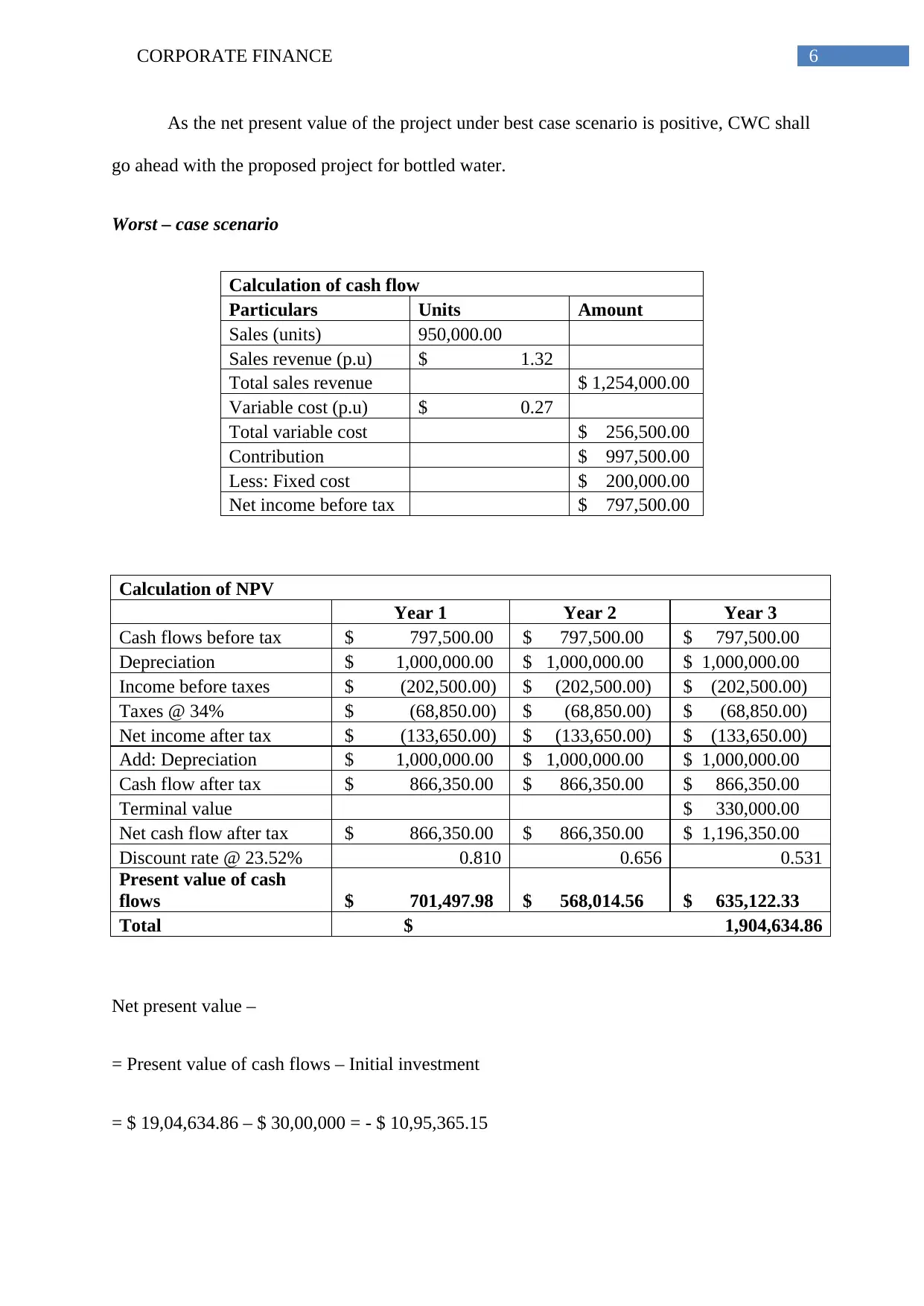
6CORPORATE FINANCE
As the net present value of the project under best case scenario is positive, CWC shall
go ahead with the proposed project for bottled water.
Worst – case scenario
Calculation of cash flow
Particulars Units Amount
Sales (units) 950,000.00
Sales revenue (p.u) $ 1.32
Total sales revenue $ 1,254,000.00
Variable cost (p.u) $ 0.27
Total variable cost $ 256,500.00
Contribution $ 997,500.00
Less: Fixed cost $ 200,000.00
Net income before tax $ 797,500.00
Calculation of NPV
Year 1 Year 2 Year 3
Cash flows before tax $ 797,500.00 $ 797,500.00 $ 797,500.00
Depreciation $ 1,000,000.00 $ 1,000,000.00 $ 1,000,000.00
Income before taxes $ (202,500.00) $ (202,500.00) $ (202,500.00)
Taxes @ 34% $ (68,850.00) $ (68,850.00) $ (68,850.00)
Net income after tax $ (133,650.00) $ (133,650.00) $ (133,650.00)
Add: Depreciation $ 1,000,000.00 $ 1,000,000.00 $ 1,000,000.00
Cash flow after tax $ 866,350.00 $ 866,350.00 $ 866,350.00
Terminal value $ 330,000.00
Net cash flow after tax $ 866,350.00 $ 866,350.00 $ 1,196,350.00
Discount rate @ 23.52% 0.810 0.656 0.531
Present value of cash
flows $ 701,497.98 $ 568,014.56 $ 635,122.33
Total $ 1,904,634.86
Net present value –
= Present value of cash flows – Initial investment
= $ 19,04,634.86 – $ 30,00,000 = - $ 10,95,365.15
As the net present value of the project under best case scenario is positive, CWC shall
go ahead with the proposed project for bottled water.
Worst – case scenario
Calculation of cash flow
Particulars Units Amount
Sales (units) 950,000.00
Sales revenue (p.u) $ 1.32
Total sales revenue $ 1,254,000.00
Variable cost (p.u) $ 0.27
Total variable cost $ 256,500.00
Contribution $ 997,500.00
Less: Fixed cost $ 200,000.00
Net income before tax $ 797,500.00
Calculation of NPV
Year 1 Year 2 Year 3
Cash flows before tax $ 797,500.00 $ 797,500.00 $ 797,500.00
Depreciation $ 1,000,000.00 $ 1,000,000.00 $ 1,000,000.00
Income before taxes $ (202,500.00) $ (202,500.00) $ (202,500.00)
Taxes @ 34% $ (68,850.00) $ (68,850.00) $ (68,850.00)
Net income after tax $ (133,650.00) $ (133,650.00) $ (133,650.00)
Add: Depreciation $ 1,000,000.00 $ 1,000,000.00 $ 1,000,000.00
Cash flow after tax $ 866,350.00 $ 866,350.00 $ 866,350.00
Terminal value $ 330,000.00
Net cash flow after tax $ 866,350.00 $ 866,350.00 $ 1,196,350.00
Discount rate @ 23.52% 0.810 0.656 0.531
Present value of cash
flows $ 701,497.98 $ 568,014.56 $ 635,122.33
Total $ 1,904,634.86
Net present value –
= Present value of cash flows – Initial investment
= $ 19,04,634.86 – $ 30,00,000 = - $ 10,95,365.15
Paraphrase This Document
Need a fresh take? Get an instant paraphrase of this document with our AI Paraphraser
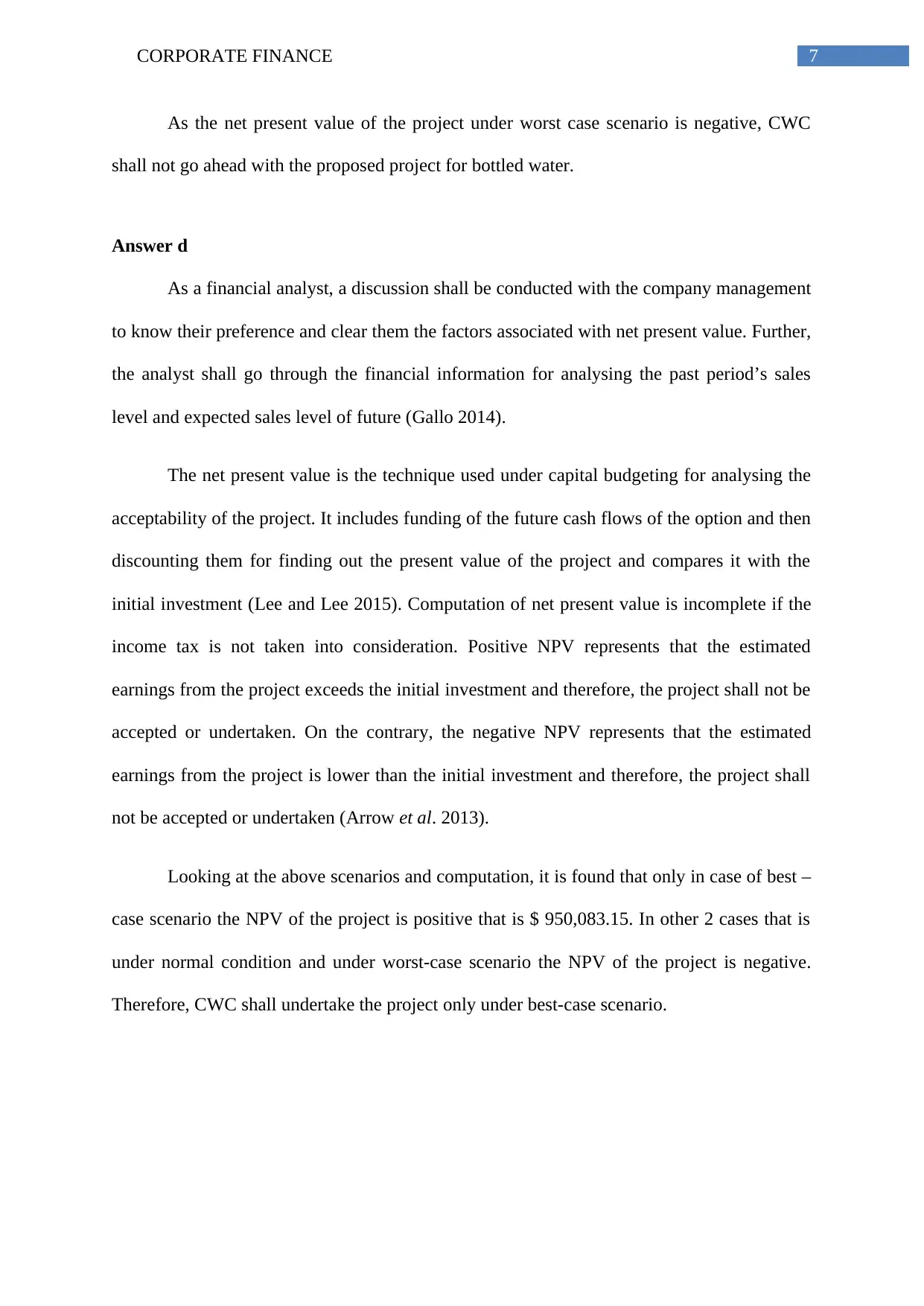
7CORPORATE FINANCE
As the net present value of the project under worst case scenario is negative, CWC
shall not go ahead with the proposed project for bottled water.
Answer d
As a financial analyst, a discussion shall be conducted with the company management
to know their preference and clear them the factors associated with net present value. Further,
the analyst shall go through the financial information for analysing the past period’s sales
level and expected sales level of future (Gallo 2014).
The net present value is the technique used under capital budgeting for analysing the
acceptability of the project. It includes funding of the future cash flows of the option and then
discounting them for finding out the present value of the project and compares it with the
initial investment (Lee and Lee 2015). Computation of net present value is incomplete if the
income tax is not taken into consideration. Positive NPV represents that the estimated
earnings from the project exceeds the initial investment and therefore, the project shall not be
accepted or undertaken. On the contrary, the negative NPV represents that the estimated
earnings from the project is lower than the initial investment and therefore, the project shall
not be accepted or undertaken (Arrow et al. 2013).
Looking at the above scenarios and computation, it is found that only in case of best –
case scenario the NPV of the project is positive that is $ 950,083.15. In other 2 cases that is
under normal condition and under worst-case scenario the NPV of the project is negative.
Therefore, CWC shall undertake the project only under best-case scenario.
As the net present value of the project under worst case scenario is negative, CWC
shall not go ahead with the proposed project for bottled water.
Answer d
As a financial analyst, a discussion shall be conducted with the company management
to know their preference and clear them the factors associated with net present value. Further,
the analyst shall go through the financial information for analysing the past period’s sales
level and expected sales level of future (Gallo 2014).
The net present value is the technique used under capital budgeting for analysing the
acceptability of the project. It includes funding of the future cash flows of the option and then
discounting them for finding out the present value of the project and compares it with the
initial investment (Lee and Lee 2015). Computation of net present value is incomplete if the
income tax is not taken into consideration. Positive NPV represents that the estimated
earnings from the project exceeds the initial investment and therefore, the project shall not be
accepted or undertaken. On the contrary, the negative NPV represents that the estimated
earnings from the project is lower than the initial investment and therefore, the project shall
not be accepted or undertaken (Arrow et al. 2013).
Looking at the above scenarios and computation, it is found that only in case of best –
case scenario the NPV of the project is positive that is $ 950,083.15. In other 2 cases that is
under normal condition and under worst-case scenario the NPV of the project is negative.
Therefore, CWC shall undertake the project only under best-case scenario.
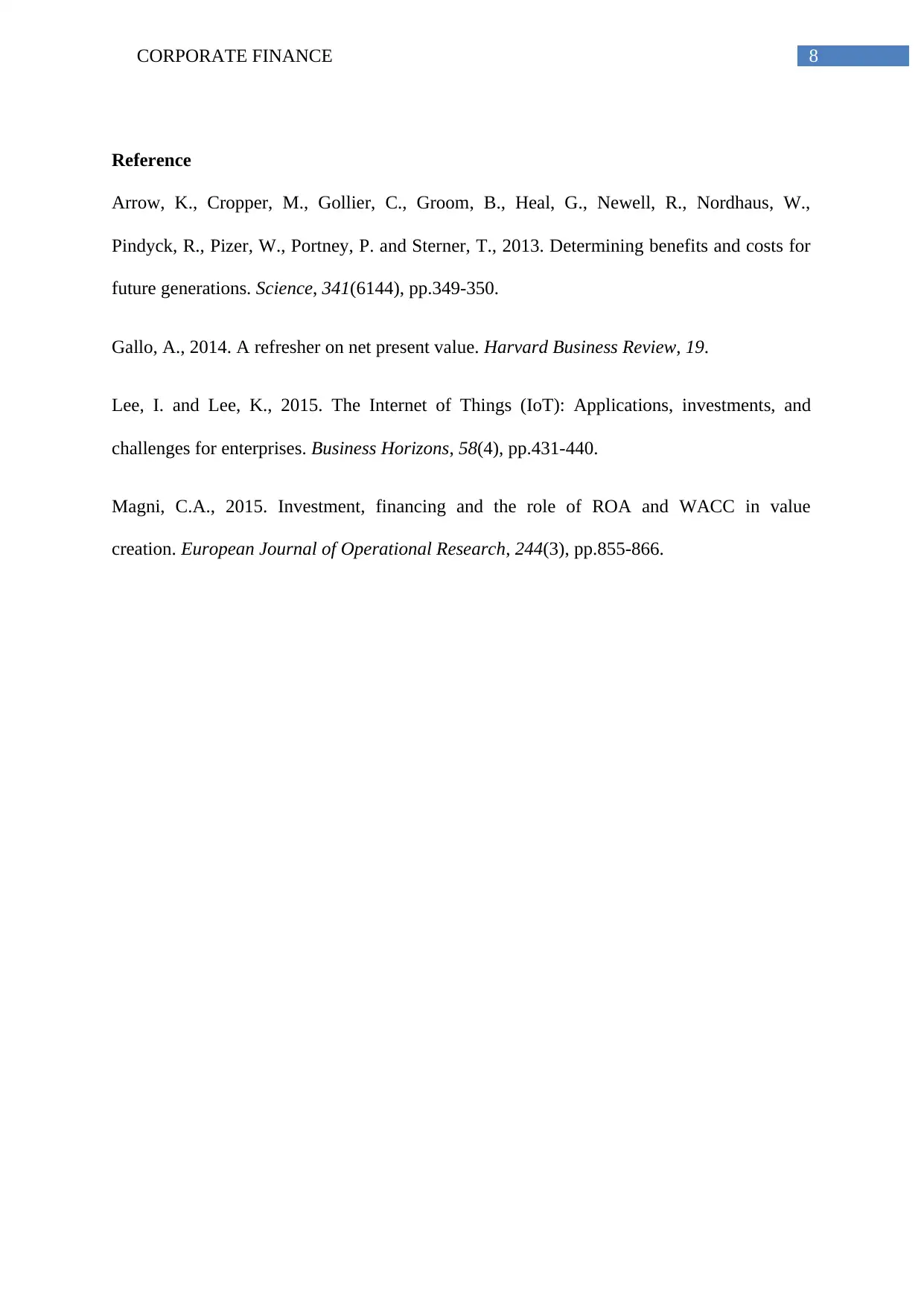
8CORPORATE FINANCE
Reference
Arrow, K., Cropper, M., Gollier, C., Groom, B., Heal, G., Newell, R., Nordhaus, W.,
Pindyck, R., Pizer, W., Portney, P. and Sterner, T., 2013. Determining benefits and costs for
future generations. Science, 341(6144), pp.349-350.
Gallo, A., 2014. A refresher on net present value. Harvard Business Review, 19.
Lee, I. and Lee, K., 2015. The Internet of Things (IoT): Applications, investments, and
challenges for enterprises. Business Horizons, 58(4), pp.431-440.
Magni, C.A., 2015. Investment, financing and the role of ROA and WACC in value
creation. European Journal of Operational Research, 244(3), pp.855-866.
Reference
Arrow, K., Cropper, M., Gollier, C., Groom, B., Heal, G., Newell, R., Nordhaus, W.,
Pindyck, R., Pizer, W., Portney, P. and Sterner, T., 2013. Determining benefits and costs for
future generations. Science, 341(6144), pp.349-350.
Gallo, A., 2014. A refresher on net present value. Harvard Business Review, 19.
Lee, I. and Lee, K., 2015. The Internet of Things (IoT): Applications, investments, and
challenges for enterprises. Business Horizons, 58(4), pp.431-440.
Magni, C.A., 2015. Investment, financing and the role of ROA and WACC in value
creation. European Journal of Operational Research, 244(3), pp.855-866.
⊘ This is a preview!⊘
Do you want full access?
Subscribe today to unlock all pages.

Trusted by 1+ million students worldwide
1 out of 9
Your All-in-One AI-Powered Toolkit for Academic Success.
+13062052269
info@desklib.com
Available 24*7 on WhatsApp / Email
![[object Object]](/_next/static/media/star-bottom.7253800d.svg)
Unlock your academic potential
Copyright © 2020–2025 A2Z Services. All Rights Reserved. Developed and managed by ZUCOL.


